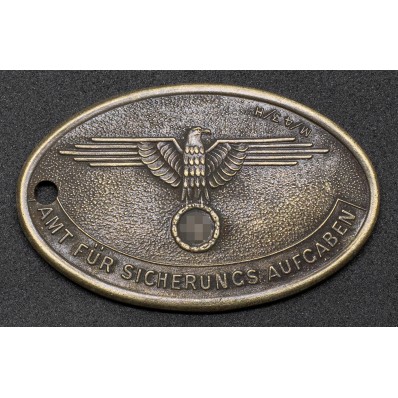No products
Product successfully added to your shopping cart
There are 0 items in your cart. There is 1 item in your cart.
ID Tag - SS Heimwehr Danzig
New
The SS Heimwehr Danzig was a short-lived military formation of Nazi Germany, formed in 1939 in the Free City of Danzig (now Gdańsk, Poland). It played a role in the opening stages of World War II, specifically during the German invasion of Poland.
- Satisfied or refunded: we guarantee 100% secure protection on your purchases
- Free return: return your order free of charge within 30 days from receipt
- Secure payments: pay securely online with PayPal or credit cards

More info
The SS Heimwehr Danzig was a short-lived military formation of Nazi Germany, formed in 1939 in the Free City of Danzig (now Gdańsk, Poland). It played a role in the opening stages of World War II, specifically during the German invasion of Poland.
Origins and Formation
The unit was established in the summer of 1939 as a paramilitary force composed of ethnic Germans from Danzig. At the time, the Free City of Danzig was a semi-autonomous region under the protection of the League of Nations, but it had strong ties to Nazi Germany. The local Nazi-controlled Senate actively supported German territorial ambitions, and the formation of the SS Heimwehr Danzig was part of the preparations for war. The unit was primarily recruited from the Danzig Police, SS volunteers, and members of local paramilitary groups sympathetic to the Nazi regime. It was formally placed under the control of the Waffen-SS and received German training and equipment.
Role in the Invasion of Poland (1939)
On September 1, 1939, as Germany launched its invasion of Poland, the SS Heimwehr Danzig took part in military operations in and around Danzig. One of its first actions was participating in the attack on the Polish Post Office in Danzig, a fiercely defended stronghold where Polish postal workers and guards resisted for several hours before being overwhelmed. Another key action was the assault on the Westerplatte, a Polish military transit depot that also put up stiff resistance before surrendering after seven days of fighting.
The unit’s role in these battles was to secure the city and eliminate Polish resistance. However, its members were also involved in reprisals and executions against Polish officials and civilians.
Dissolution and Integration
After the fall of Danzig, the SS Heimwehr Danzig no longer had a strategic purpose as an independent unit. It was soon absorbed into the SS Totenkopf Division, one of the Waffen-SS’s most infamous formations, known for its brutal actions on the Eastern Front. Many of its members went on to serve in the division during operations in France and later in the Soviet Union.
Legacy and Controversy
The SS Heimwehr Danzig is remembered mainly for its role in the invasion of Poland and the subsequent atrocities committed against Polish forces and civilians. Its involvement in the attacks on the Polish Post Office and Westerplatte are among the most well-documented events of the early war.
Though a relatively small unit, its actions were symbolic of Nazi Germany’s aggression and the brutal occupation policies that followed. Today, in Gdańsk, memorials and museums preserve the memory of the Polish defenders who resisted against overwhelming odds.
Data sheet
| Width | 38.5 mm |
| Lenght | 60.5 mm |
| Thickness | 2.8 mm |
ID Tags
- Germany
- Medals, Orders and Decorations
- Badges and Pins
- ID Tags
- Arm Shields
- Visor Caps and Hats
- Cap and Helmet Badges
- Collar Tabs Cyphers
- Collar Tabs, Shoulder Boards and Epaulettes
- Arm Bands
- Division Cuff Titles
- Buckles And Belts
- Buttons For Uniforms
- Stamps
- Gorgets
- Rings
- SS Honour Ring in 925 Silver - Collector's Set
- Poletops
- Flags
- Daggers and Knives (Ornamental)
- Field Marshal Batons
- Ammo Pouches, Bandoliers and Bags
- Service Watches
- Presentation Cases
- Documents and Award Letters
- Busts, Eagles, Lighters and Miscellaneous
- Croatian and Ustasha Militaria
- Denazified Articles
- Commemorative Necklaces
- Spare Parts, Small Parts and Accessories
- Italy
- Medals and Decorations
- Brevets And Badges
- Battle Shields and Tags
- Gorgets
- Visor Caps and Hats
- Cap and Helmet Badges
- Friezes for Collar Tabs
- Collar Tabs, Shoulder Boards and Epaulettes
- Buckles
- Belts
- Buttons For Uniforms
- Rings
- Poletops
- Italian Resistance
- Keyrings
- Wallshields
- Daggers and Knives
- Flags
- Busts and Eagles
- Souvenirs
- Commemorative Necklaces
- Imperial Germany
- Soviet Union
- Other Countries






